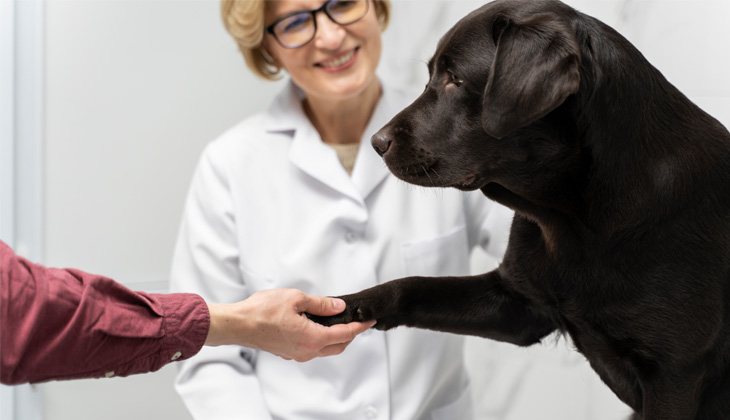What You Need to Know about Canine Distemper
HEALTH & PROTECTION
30 Mar, 2022
5 minutes

After a routine visit to your veterinarian, you may have seen “DHPPi” or “DAPPv” on your paperwork and wondered what it means. The “D” in this vaccine stands for distemper, considered one of the most serious diseases your dog can get.
Distemper in dogs can turn fatal very quickly, which is why you want to make sure your dog is vaccinated against it. The vaccine against distemper is considered one of the core vaccines for dogs, along with the vaccines against canine parvovirosis, infectious canine hepatitis (caused by canine adenovirus type 1), and rabies (in countries where this disease is present).
For more information every dog owner should know about distemper, keep reading!

What is canine distemper?
Canine distemper is a highly contagious, often fatal viral disease that affects the respiratory, gastrointestinal (GI), and nervous systems of dogs. The virus that causes distemper is closely related to the measles virus and causes severe illness by attacking multiple body systems, resulting in widespread damage that is difficult to treat.
How is canine distemper spread?
Canine distemper is mainly transmitted by respiratory secretions, like coughing or sneezing, similar to the way a common cold is spread in humans. When an infected dog or wild animal coughs, sneezes, or barks, aerosol droplets are released into the environment, infecting nearby animals and surfaces, like food and water bowls. A dog’s sneeze can actually spread respiratory particles up to 25 feet, making the risk of exposure extremely high.
Fortunately, the virus does not last long in the environment and is easily destroyed by disinfectants. An infected dog, however, can continue transmitting the virus for up to two to three months, putting dogs around them at risk.
Wild animals, such as raccoons, foxes, wolves, coyotes, skunks and ferrets can also get distemper, which means that an outbreak of distemper in the local wildlife population can also put dogs at risk.
Pregnant dogs can also spread the virus to their puppies through the placenta.
What are the signs of canine distemper?
Dogs with distemper usually show a wide range of signs depending on how advanced the disease is in their bodies. Once a dog becomes infected, the virus initially replicates in the lymphatic tissue of the respiratory tract before moving on to infect the rest of the dog’s lymphatic system, the respiratory tract, the GI tract, the central nervous system, and other crucial systems. Overall, signs are usually observed in two stages.
Stage one of distemper in dogs generally presents with ocular, respiratory and/or gastrointestinal signs, with some or all of the following:
- Fever (most dogs develop a fever 3 to 6 days after being infected)
- Eating less than usual
- Depression
- Purulent ocular discharge
- Purulent nasal discharge
- Coughing
- Difficulty breathing (dyspnoea)
- Vomiting
- Diarrhea
As the disease progresses, some dogs develop neurological signs as it attacks the central nervous system. These signs are part of stage two:
- Head tilt
- Circling
- Partial or full paralysis
- Seizures
- Nystagmus (repetitive eye movements)
- Muscle twitching
- Convulsions with increased salivation and chewing motions
- Death, in a number of cases
Which dogs are most at risk for distemper?
Unvaccinated puppies under four months old are particularly susceptible to canine distemper, although all unvaccinated dogs are at risk of disease.
If you observe any signs of distemper in your puppy, call your veterinarian immediately.

How do you treat canine distemper?
Unfortunately, there is no cure for distemper. Positive cases of canine distemper require isolation from all other animals and usually hospitalization.
Veterinarians diagnose distemper through a combination of assessing clinical signs and doing diagnostic tests. Once diagnosed, distemper treatment for dogs is purely supportive. Veterinarians can provide treatment for the diarrhea, vomiting and associated dehydration; support for neurological signs such as seizures, respiratory support for pneumonia, and they will try to prevent secondary infections.
The survival rate and length of infection depend on the strain of the virus and on the strength of the dog’s immune system. Dogs can live once they have been infected with distemper, but they may develop lifelong debilitating nervous system issues. Adult dogs are more likely to survive than puppies.
How do you prevent canine distemper?
The good news is that canine distemper is entirely preventable. Several things you can do to prevent your beloved pooch from getting distemper include:
- Make sure your puppy or new dog gets his or her full series of distemper vaccinations at the recommended ages
- Keep distemper vaccinations up-to-date throughout your dog’s life and avoid any gaps in vaccinations
- Keep your dog away from infected animals and wildlife
- Be careful socializing your puppy until the full initial course of distemper vaccinations has been completed, especially in places where dogs congregate (dog parks, classes, doggy day care)
- If you have a pet ferret, talk to your veterinarian about getting him vaccinated for distemper too!
- And always, if you have any questions or concerns, consult your veterinarian
RECOMMENDED
POPULAR PAGES
RELATED POSTS
-

Finding out your dog or cat has diabetes can be a lot to digest, learn all the terms so you can ask the right questions and stay on top of your pet’s needs.
-

Pets do not understand the holidays period which change their routines. Here are 6 tips to create a pet friendly home during Chrismas!
-

It is important to know about rabies and how to protect our families. Protect your pet from rabies with an up-to-date vaccination from your veterinarian.
-

Your beloved cats can also suffer from cold and flu. In this article learn how to protect your cat during cold periods.






